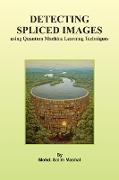- Start
- Detecting Spliced Images Using Quantum Machine Learning Techniques
Detecting Spliced Images Using Quantum Machine Learning Techniques
Angebote / Angebote:
Image forgery is a growing concern in today's era of extensive use of social media. It has
changed the way people normally stored, accessed and shared data. Visual imagery has
impacted the routine of documenting evidences and sharing information. Amidst all this
if false information in the form of doctored images are circulated, it misleads people into
drawing false conclusions. Such incidents affect courtroom trials, medical and scientific
research, political campaigns, fashion industry, media and social networking platforms. It
therefore becomes important to differentiate between authentic and forged (or doctored or
tampered) images. The common forms of image forgery include, copy-move and splicing,
along with a series of post-processing operations using sophisticated yet user-friendly image
editing tools for more realistic forgery. Image forensic techniques find traces of image
manipulations by analyzing the image pixels, investigating camera induced and compression
artefacts, studying geometrical and physics based properties of objects captured in the
image. The techniques focus on active and passive detection by classifying authentic vs.
doctored images and extend this to localizing the region on forgery. Earlier work on signal
processing and machine learning techniques have proven effective in detecting the traces of
these image manipulations. Very recently, work in the area of deep learning has showed
remarkable improvements in detecting image manipulations. This work focuses on the
application of (1) machine learning, (2) deep learning and (3) quantum machine learning
techniques to image splicing detection. In (1), features from spliced and authentic images
are engineered by applying the Kekre, discrete cosine, and the hybrid Kekre-discrete cosine
transforms which are then passed onto an assortment of machine learning classifiers to
classify spliced images. For (2), a novel socio-inspired twin convolutional neural network
with a feature-transfer learning approach, named "MissMarple" is proposed to detect traces
of image splicing.
Folgt in ca. 15 Arbeitstagen
